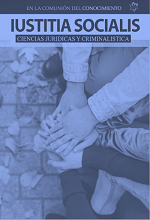Child labor in the COVID-19 pandemic
DOI:
https://doi.org/10.35381/racji.v5i3.1113Keywords:
Child labor, life conditions, humanitarian support.Abstract
The general objective of the research was to analyze the violation of rights in child labor in times of the covid-19 pandemic at the fair and streets, Pucará neighborhood. It was developed from a quantitative approach with a descriptive methodology with a non-experimental design, which was supported by the documentary-bibliographic analysis, through the analytical-synthetic method, which allowed to structure the theoretical composition of the legal argument. The sample consisted of 27 people (men and women) between 15 and 30 years of age, eradicated in the neighborhood of Pucará-Ecuador, who were given a survey. The collected data were analyzed through descriptive statistics and content analysis, which allowed the construction of a results section. It is concluded that the State, decentralized organizations and the population, in general, must ensure compliance with the norms that protect children and adolescents with greater emphasis in this time of pandemic.
Downloads
References
Asamblea Nacional Constituyente de la República del Ecuador, (2008). Constitución de la República del Ecuador. Montecristi. Registro Oficial 449 de 20-oct-2008. Recuperado de https://n9.cl/sia
Asamblea Nacional del Ecuador. (2009). Ley Reformatoria al Código de la Niñez y Adolescencia. [Reform Law to the Childhood and Adolescence Code] Quito: Asamblea Nacional del Ecuador. Obtenido de https://n9.cl/ul23i
Asamblea Nacional del Ecuador. (2020). Ley Orgánica de Apoyo Humanitario. [Organic Humanitarian Support Act]. Registro Oficial Suplemento 229 de 22-jun-2020
Congreso Nacional. (2002). Código de la niñez y adolescencia. [Childhood and Adolescence Code]. Quito.
Gobierno Nacional, mediante Acuerdo Ministerial Nro. MDT-2018-0158, Proyecto de Erradicación del trabajo Infantil. [Child Labour Eradication Project]. Publicado en el Registro Oficial Nro. 289, de 23 de julio de 2018
González-Cárdenas, F., Narváez-Zurita C., Guerra-Coronel M. & Erazo-Álvarez, J. (2020). Protección para niños, niñas y adolescentes: La protección integral prevista en la constitución ecuatoriana. [Protection for children and adolescents: The comprehensive protection provided for in the Ecuadorian constitution] IUSTITIA SOCIALIS. 5(1), 397-414. http://dx.doi.org/10.35381/racji.v5i1.619
OIT. (2007). Organización Internacional del Trabajo. Recuperado de: https://n9.cl/9yddy
Peraza de Aparicio, C. (2020). Salud laboral frente a la pandemia del COVID-19 en Ecuador. [Occupational health facing COVID-19 pandemic in Ecuador]. Medisur, 18(3), 507-511. Recuperado de: https://n9.cl/a5dgs
Pinzón-Rondón, A., Briceño-Ayala, L., Botero, J., Cabrera, P., & Rodríguez, N. (2006). Trabajo infantil ambulante en las capitales latinoamericanas. [Street child labour in Latin American capitals]. SALUD PÚBLICA DE MÉXICO. 48(5),363-372. Recuperado de: https://n9.cl/pza5
Serrano-Guzmán, María, Serrano-Guzmán, Mónica, Mármol-Ríos, Marina. & Mesa-Rivera, Marisol (2015) Impacto de trabajo infantil en el rendimiento escolar de adolescentes en poblaciones rurales: estudio de caso. [Impact of child labor on the academic performance of adolescents from rural areas: a case study] Revista Lasallista de Investigación. 12(1), 147-153. Recuperado de: http://www.scielo.org.co/pdf/rlsi/v12n1/v12n1a14.pdf
Published
How to Cite
Issue
Section
License
CC BY-NC-SA : Esta licencia permite a los reutilizadores distribuir, remezclar, adaptar y construir sobre el material en cualquier medio o formato solo con fines no comerciales, y solo siempre y cuando se dé la atribución al creador. Si remezcla, adapta o construye sobre el material, debe licenciar el material modificado bajo términos idénticos.
OAI-PMH URL: https://fundacionkoinonia.com.ve/ojs/index.php/Iustitia_Socialis/oai










